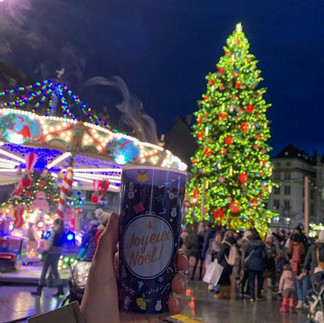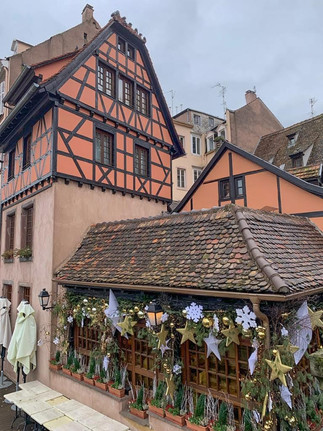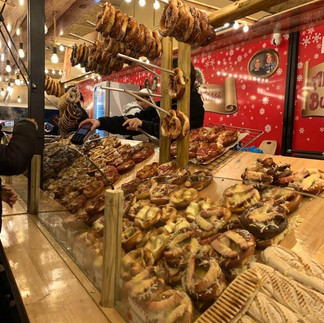6 Reasons Why Strasbourg is the Perfect (Christmas) City Trip Destination
- Eliška Brotánková
- Dec 25, 2023
- 4 min read
Strasbourg is a city in France and a historic metropole of the Alsace region. It lays on the Rhine river which also marks the border between France and Germany. With the seat of the European Parliament and the Council of Europe, it is considered the Capital of Europe. It's one of the most popular places to visit during Christmas and famous for its Christmas markets and rich festive decorations.
In this article, we are bringing you a few reasons why you definitely should not miss this city!
Capital of Christmas
Dating back to 1570, Christkindelsmärik is the oldest Christmas market in France and in Europe.
The idea behind declaring the city the Christmas Capital was mostly commercial, to attract more visitors. Which worked pretty well!
The Great Christmas Tree
The symbol of Strasbourg is located at Place Kléber. It is 70 years old and with its nearly 30 meters, it's the highest decorated tree in Europe!
Also, the Christmas tree tradition, as we know it nowadays, started in the Alsace region. Glass balls to hang on trees were first invented here - before that, people used to hang apples and brezels on the trees but one winter there was not enough apples so glassmakers replaced them with balls they made themselves.
La Grande Île
"The big island" of Strasbourg is reasonably listed as a UNESCO World Heritage site. The area marks the historic centre, which lights up all festive during the Christmas season.
Strasbourg boats a remarkable collection of well-preserved medieval and Renaissance architecture. The city's historic center, with its timber-framed houses, ornate facades, and cobblestone streets, creates a captivating atmosphere that transports visitors to the past.
The Cathedral, also known as Cathedral Notre-Dame, is a masterpiece of Gothic architecture. Its intricate carvings, stunning stained glass windows, and the impressive facade featuring the iconic astronomical clock make it a must-see for architecture enthusiasts.
Strasbourg's charming neighbourhoods, including Petite France that dates back to the 16th century, showcase a wealth of colourful half-timbered houses. These structures, characterised by exposed wooden frames, contribute to the city's unique and timeless aesthetic. Originally a miller's district, the area later became known for its tanners, fishermen, and mill workers.
The area is intersected by a network of canals and the River III, creating a romantic and idyllic atmosphere. Bridges connect the narrow streets and offer beautiful views of the waterways and historic buildings. You will also find here many artisan and souvenir shops and cafés with Alsatian cuisine.
Blend of influences
From the Gothic beauty of Cathedral Notre-Dame to the half-timbered houses in Petite France, every corner tells a story. UNESCO-listed, reflecting 20 centuries of both French and German influences, it's a unique place that survived the wars untouched.
Due to its location right on the French-German border, the city reflects a harmonious blend of the two countries. Strasbourg and the whole Alsace region have been passed between both of the countries' control several times, so the culture, including the cuisine, dialect and architecture is a unique fusion of both! Some say, Alsace is neither French, nor German.
The Alsatian cuisine
Traditional specialties such as bredele (traditional Christmas cookies), tarte flambée (alias Flammkuchen), foie gras and vin chaud (red mulled wine) are definitely worth the visit. Do not miss the Munster cheese which they put literally on everything, even on a Bratwurst! (You can also smell it everywhere haha)
Free walking tours
There are plenty of tours without set prices, where you decide how much to pay the guide depending on how you liked it. We like the idea and are always happy to support local guides in doing what they love.
We booked online via GuruWalk, but as we found out later, there's no need to book. Most of the people joining our group just showed up at the meeting point (in front of the Notre Dame Cathedral) or joined on the way - you should recognise the guide easily as he holds a big sign saying "Happy free walking tours". They offer two different types of tour - one is about the city in general, including more details about the Cathedral, the other one is specifically about La Petite France district. We only did the second one, as the general tour was too late for our plans.
Tip: One day trip to Colmar
This cute town is only an hour drive from Strasbourg and has the most Christmassy atmosphere! Similar to Strasbourg, it's celebrated for its picturesque canals, medieval architecture, and cobblestone streets.
The historic Old Town, particularly in areas like "La Petite Venise", offers a fairy-tale-like setting. This romantic canal-lined district is characterized by charming waterside houses and bridges.
Colmar is situated in the heart of the Alsace wine region, known for its excellent white wines. Visitors can explore local wineyards, wine cellars, and tasting rooms to savor the distinct flavours of Alsace wines.
The Unterlinden Museum, housed in a former Domician convent, showcases an impressive collection of art and artifacts, including the Isenheim Altarpiece by Matthias Grünewald. It provides insights into the rich cultural heritage of the region.
During the Christmas season, Colmar transforms into a winter wonderland with its festive markets and decorations. Every corner is calling for attention and makes you want to take pictures.
Fun fact: There is a Statue of Liberty in Colmar! It's standing on a roundabout at the northern entrance to the city. It was sculpted to commemorate the 100th death anniversary of Auguste Bartholdi, the scupltor of the original "Liberty lightening the world", who was born in Colmar.

In the city centre you will keep seeing metal arrows with the symbol of Statue of Liberty on the ground - these are pointing to the most significant sights of the town.







































































































Comments